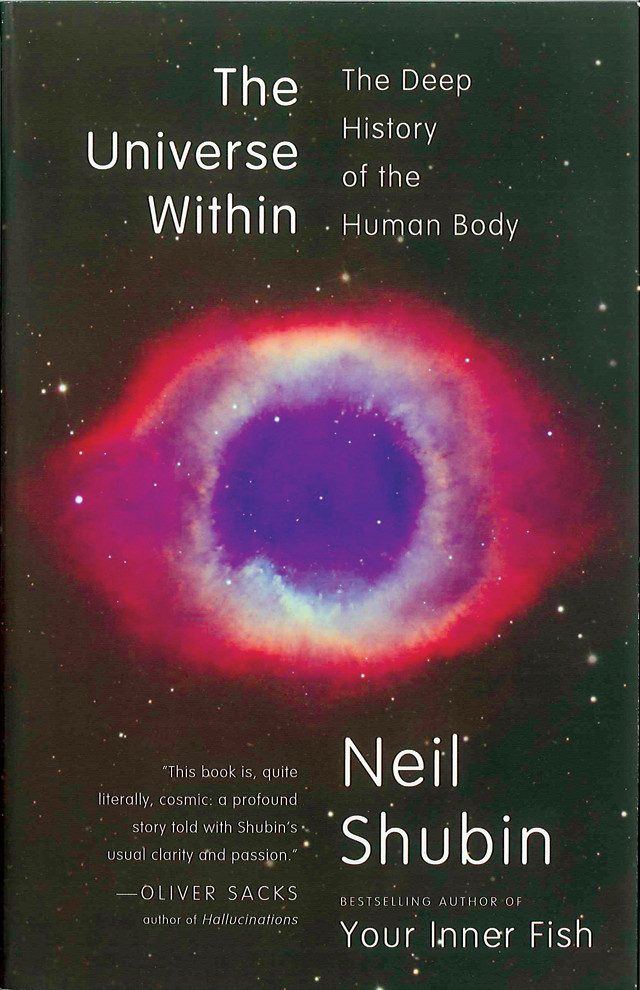
by Callan Bentley Friday, January 30, 2015

"The Universe Within: The Deep History of the Human Body," by Neil Shubin, Vintage, 2013, 978-0307473271.
In 2008, Neil Shubin penned the terrific, “Your Inner Fish: A Journey into the 3.5-Billion-Year History of the Human Body,” in which he explored the stories of deep time as they are written in the details of our bodily architecture. As both a professor of anatomy and the paleontologist who discovered Tiktaalik, a transitional fossil between fish and amphibians, Shubin was ideally positioned to tell this tale.
The same is not true, however, of the story in his new book, “The Universe Within: The Deep History of the Human Body.” This book has a much broader scope — rather than going back merely to the Cambrian, it stretches all the way to the Big Bang — some of which falls outside Shubin’s expertise. “The Universe Within” covers elemental nucleosynthesis, cosmic background radiation and redshift, which are all fascinating topics, but the book doesn’t really come alive until there’s an opportunity for Shubin to discuss the evolutionary trajectory of our fleshy ancestors. In other words, the parts of the new book that work best are those that most closely resemble “Your Inner Fish.”
Regardless, in addition to his paleontological and anatomical bona fides, Shubin is also a talented writer and popularizer of science. For instance, he uses little jargon in discussing isotopic evidence of the moon’s origin; specifically, he makes no mention of the word “isotope” at all. Instead, it’s “neutron-heavy” and “neutron-light” versions of oxygen that make the case for the moon forming at the same distance from the sun as Earth. On the other hand, sometimes his effort to popularize goes too far. A page after describing the moon’s formation, Shubin likens the early solar system to a “cosmic demolition derby,” but then perhaps he felt that too few of his readers would have had experience with a demolition derby, because he applies yet another metaphor: an “automotive mosh pit.”
“The Universe Within” has its share of imperfections — the graphics are particularly lacking, for example — but those who haven’t yet explored cosmology or Earth history in great depth will likely enjoy it. Other readers may also learn something new — perhaps, for example, the story of John Phillips, the nephew of geologist William Smith who drew the “map that changed the world” as chronicled by Simon Winchester. Smith’s use of the principle of fossil succession in correlating strata was an inspiration to his ward, Phillips. In 1855, Phillips synthesized the major faunal turnovers seen in the fossil record, taking them as indicators of prominent changes in Earth history, and used them as the basis for naming the Paleozoic, Mesozoic and Cenozoic eras of geological time.
The book also makes a few great points in innovative ways I hadn’t previously seen. The second chapter opens, for instance, with the chemical formula for a human being, down to the last atom of cobalt. It’s a fresh way of looking at the question of our fundamental makeup. What are our ingredients, and where did they come from? Shubin is happy to tell you. Everything we are made of, every physical transaction we make, is an act of intimate communion with the entire universe. This perspective is profound, enlightening and — best of all — true.
It’s an exquisite moment when one grasps humanity’s feeble position on the lip of a yawning chasm 13.7 billion years deep, one that is both insignificant relative to the vastness of space-time, and yet also the manifestation of processes both cosmic and atomic. It is surely some sort of evolutionary culmination to be able to look back on where we’ve come from with such a humble sense of awe.
In spring 2014, Shubin hosted a television series based on “Your Inner Fish.” Delightfully, it aired contemporaneously with astrophysicist Neil deGrasse Tyson’s reboot of “Cosmos.” The two Neils hosting two prime-time science shows both did an outstanding job, and offered the science-interested citizenry a beacon of intellectual stimulation amid the typical morass of TV programming. Nevertheless, although Shubin can tell the tales of our animal ancestors startlingly well, I feel the cosmology is best left to Tyson.
© 2008-2021. All rights reserved. Any copying, redistribution or retransmission of any of the contents of this service without the expressed written permission of the American Geosciences Institute is expressly prohibited. Click here for all copyright requests.